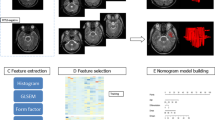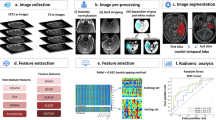Abstract
Objectives
To develop and validate a radiomics-based model for predicting radiation-induced temporal lobe injury (RTLI) in nasopharyngeal carcinoma (NPC) by pretreatment MRI of the temporal lobe.
Methods
A total of 216 patients with diagnosed NPC were retrospectively reviewed. Patients were randomly allocated to the training (n = 136) and the validation cohort (n = 80). Radiomics features were extracted from pretreatment contrast-enhanced T1- or fat-suppressed T2 weighted MRI. A radiomics signature was generated by the least absolute shrinkage and selection operator (LASSO) regression algorithm, Pearson correlation analysis, and univariable logistic analysis. Clinical features were selected with logistic regression analysis. Multivariable logistic regression analysis was conducted to develop three models for RTLI prediction in the training cohort: namely radiomics signature, clinical variables, and clinical-radiomics parameters. A radiomics nomogram was used and assessed with respect to calibration, discrimination, reclassification, and clinical application.
Results
The radiomics signature, composed of two radiomics features, was significantly associated with RTLI. The proposed radiomics model demonstrated favorable discrimination in both the training (AUC, 0.89) and the validation cohort (AUC, 0.92), outperforming the clinical prediction model (p < 0.05). Combining radiomics and clinical features, higher AUCs were achieved (AUC, 0.93 and 0.95), as well as a better calibration and improved accuracy of the prediction of RTLI. The clinical-radiomics model showed also excellent performance in predicting RTLI in different clinical-pathologic subgroups.
Conclusion
A radiomics model derived from pretreatment MRI of the temporal lobe showed persuasive performance for predicting radiation-induced temporal lobe injury in nasopharyngeal carcinoma.
Key Points
• Radiomics features from pretreatment MRI are associated with radiation-induced temporal lobe injury in nasopharyngeal carcinoma.
• The radiomics model shows better predictive performance than a clinical model and was similar to a clinical-radiomics model.
• A clinical-radiomics model shows excellent performance in the prediction of radiation-induced temporal lobe injury in different clinical-pathologic subgroups.






Similar content being viewed by others
Abbreviations
- AUC:
-
Area under the curve
- IMRT:
-
Intensity-modulated radiotherapy
- NPC:
-
Nasopharyngeal carcinoma
- ROI:
-
Region of interest
- RTLI:
-
Radiotherapy-induced temporal lobe injury
- TL:
-
Temporal lobe
- VOI:
-
Volume of interests
References
Bray F, Ferlay J, Soerjomataram I, Siegel RL, Torre LA, Jemal A (2018) Global cancer statistics 2018: GLOBOCAN estimates of incidence and mortality worldwide for 36 cancers in 185 countries. CA Cancer J Clin 68:394–424 Erratum in: CA Cancer J Clin. 2020;70:313
Pfister DG, Spencer S, Adelstein D et al (2020) Head and Neck Cancers, Version 2.2020, NCCN Clinical Practice Guidelines in Oncology. J Natl Compr Canc Netw 18:873–898
Lee AW, Law SC, Ng SH et al (1992) Retrospective analysis of nasopharyngeal carcinoma treated during 1976-1985: late complications following megavoltage irradiation. Br J Radiol 65:918–928
Liang SB, Wang Y, Hu XF et al (2017) Survival and toxicities of IMRT based on the RTOG protocols in patients with nasopharyngeal carcinoma from the endemic regions of China. J Cancer 8:3718–3724
Su SF, Huang Y, Xiao WW et al (2012) Clinical and dosimetric characteristics of temporal lobe injury following intensity modulated radiotherapy of nasopharyngeal carcinoma. Radiother Oncol 104:312–316
Zhou GQ, Yu XL, Chen M et al (2013) Radiation-induced temporal lobe injury for nasopharyngeal carcinoma: a comparison of intensity-modulated radiotherapy and conventional two-dimensional radiotherapy. PLoS One 8:e67488
Lam TC, Wong FC, Leung TW, Ng SH, Tung SY (2012) Clinical outcomes of 174 nasopharyngeal carcinoma patients with radiation-induced temporal lobe necrosis. Int J Radiat Oncol Biol Phys 82:e57–e65
Abayomi OK (2002) Pathogenesis of cognitive decline following therapeutic irradiation for head and neck tumors. Acta Oncol 41:346–351
Chen W, Qiu S, Li J et al (2015) Diffusion tensor imaging study on radiation-induced brain injury in nasopharyngeal carcinoma during and after radiotherapy. Tumori 101:487–490
Guan W, Xie K, Fan Y et al (2020) Development and validation of a nomogram for predicting radiation-Induced temporal lobe injury in nasopharyngeal carcinoma. Front Oncol 10:594494
Zeng L, Huang SM, Tian YM et al (2015) Normal tissue complication probability model for radiation-induced temporal lobe injury after intensity-modulated radiation therapy for nasopharyngeal carcinoma. Radiology 276:243–249
Huang J, Kong FF, Oei RW et al (2019) Dosimetric predictors of temporal lobe injury after intensity-modulated radiotherapy for T4 nasopharyngeal carcinoma: a competing risk study. Radiat Oncol 14:31
Lee AW, Cheng LO, Ng SH et al (1990) Magnetic resonance imaging in the clinical diagnosis of late temporal lobe necrosis following radiotherapy for nasopharyngeal carcinoma. Clin Radiol 42:24–31
Chen Q, Lv X, Zhang S et al (2020) Altered properties of brain white matter structural networks in patients with nasopharyngeal carcinoma after radiotherapy. Brain Imaging Behav 14:2745–2761
Wang HZ, Qiu SJ, Lv XF et al (2012) Diffusion tensor imaging and 1H-MRS study on radiation-induced brain injury after nasopharyngeal carcinoma radiotherapy. Clin Radiol 67:340–345
Yang J, Xu Z, Gao J et al (2018) Evaluation of early acute radiation-induced brain injury: Hybrid multifunctional MRI-based study. Magn Reson Imaging 54:101–108
Giraud P, Giraud P, Gasnier A et al (2019) Radiomics and machine learning for radiotherapy in head and neck cancers. Front Oncol 9:174
Mayerhoefer ME, Materka A, Langs G et al (2020) Introduction to Radiomics. J Nucl Med 61:488–495
Wang YX, King AD, Zhou H et al (2010) Evolution of radiation-induced brain injury: MR imaging-based study. Radiology 254:210–218
Duane F, Aznar MC, Bartlett F et al (2017) A cardiac contouring atlas for radiotherapy. Radiother Oncol 122:416–422
Kim JH (2019) Multicollinearity and misleading statistical results. Korean J Anesthesiol 72:558–569
Thibault G, Fertil B, Navarro C et al (2009) Texture indexes and gray level size zone matrix. Application to cell nuclei classification. 10th International Conference on Pattern Recognition and Information Processing, PRIP 2009, Minsk, Belarus, pp 140–145
Amadasun M, King R (1989) Textural features corresponding to textural properties. IEEE Trans Syst Man Cybern 19(5):1264–1274
Tomaszewski MR, Gillies RJ (2021) The biological meaning of radiomic features. Radiology 298:505–516. https://doi.org/10.1148/radiol.2021202553 Erratum in: Radiology 2021;299:E256
Mori M, Passoni P, Incerti E et al (2017) Increased chemosensitivity and radiosensitivity of human breast cancer cell lines treated with novel functionalized single-walled carbon nanotubes. Oncol Lett 13:206–214
Jia Y, Weng Z, Wang C et al (2017) Increased chemosensitivity and radiosensitivity of human breast cancer cell lines treated with novel functionalized single-walled carbon nanotubes. Oncol Lett 13:206–214
Balentova S, Adamkov M (2015) Molecular, cellular and functional effects of radiation-induced brain injury: a review. Int J Mol Sci 16:27796–27815
Hou J, Li H, Zeng B et al (2021) MRI-based radiomics nomogram for predicting temporal lobe injury after radiotherapy in nasopharyngeal carcinoma. Eur Radiol 32:1106–1114
Zhang B, Lian Z, Zhong L et al (2020) Machine-learning based MRI radiomics models for early detection of radiation-induced brain injury in nasopharyngeal carcinoma. BMC Cancer 20:502
Miller NR (2004) Radiation-induced optic neuropathy: still no treatment. Clin Experiment Ophthalmol 32:233–235
Chan YL, Leung SF, King AD, Choi PH, Metreweli C (1999) Late radiation injury to the temporal lobes: morphologic evaluation at MR imaging. Radiology 213:800–807
Bluemke DA, Moy L, Bredella MA et al (2020) Assessing radiology research on artificial intelligence: a brief guide for authors, reviewers, and readers-from the Radiology Editorial Board. Radiology 294:487–489
Moons KG, Altman DG, Reitsma JB et al (2015) Transparent Reporting of a multivariable prediction model for Individual Prognosis or Diagnosis (TRIPOD): explanation and elaboration. Ann Intern Med 162:W1–W73
Funding
This study has received funding from the Non-profit Central Research Institute Fund of the Chinese Academy of Medical Sciences (2019XK320073).
Author information
Authors and Affiliations
Corresponding authors
Ethics declarations
Guarantor
The scientific guarantor of this publication is Dehong Luo.
Conflict of interest
The authors of this manuscript declare no relationships with any companies, whose products or services may be related to the subject matter of the article.
Statistics and biometry
One of the authors has significant statistical expertise.
Informed consent
Written informed consent was waived by the Institutional Review Board.
Ethical approval
Institutional Review Board approval was obtained.
Methodology
• retrospective
• diagnostic or prognostic study
• performed at one institution
Additional information
Publisher’s note
Springer Nature remains neutral with regard to jurisdictional claims in published maps and institutional affiliations.
Rights and permissions
About this article
Cite this article
Bao, D., Zhao, Y., Li, L. et al. A MRI-based radiomics model predicting radiation-induced temporal lobe injury in nasopharyngeal carcinoma. Eur Radiol 32, 6910–6921 (2022). https://doi.org/10.1007/s00330-022-08853-w
Received:
Revised:
Accepted:
Published:
Issue Date:
DOI: https://doi.org/10.1007/s00330-022-08853-w




